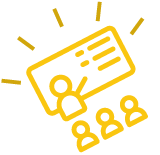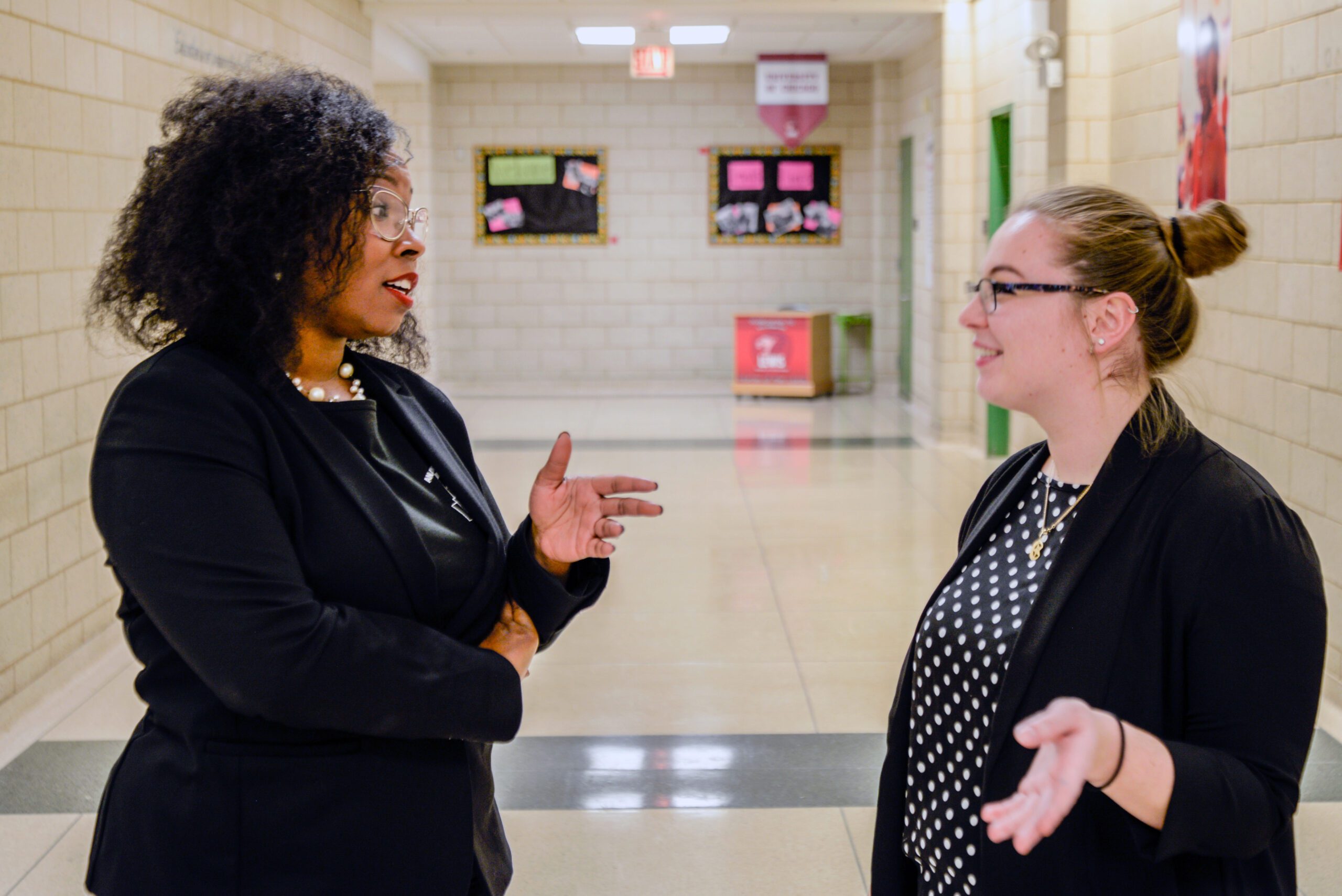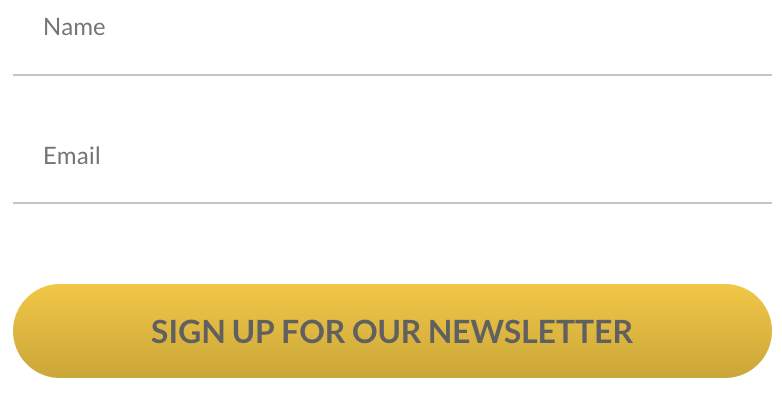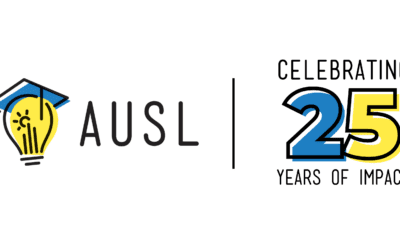[vc_row][vc_column][stm_title title_tag=”h3″ sep_enable=”true” title=”Driving Instructional Excellence and Building School Capacity”][/stm_title][/vc_column][/vc_row][vc_row][vc_column width=”1/2″][vc_single_image image=”5548″ img_size=”full”][/vc_column][vc_column width=”1/2″][vc_column_text]This AUSLinnovates story is a follow-up to Part One: professional learning and when and where it happens at AUSL. This story is focused on the school and network conditions that enable that professional learning to occur. It is drawn from an interview with Principal Aquabah Gonney and Edina Malagic, eighth grade teacher, of Lewis School of Excellence in Chicago’s North Austin neighborhood.[/vc_column_text][/vc_column][/vc_row][vc_row equal_height=”yes” content_placement=”middle” css=”.vc_custom_1520615726137{padding-bottom: 20px !important;}”][vc_column width=”1/2″][vc_column_text]AUSL was founded as a teacher residency program, focused on creating highly effective teachers. This belief in excellence in teaching as the key to transformative student learning has evolved as AUSL has evolved and underpins all of our day-to-day work across our network of public neighborhood schools.[/vc_column_text][/vc_column][vc_column width=”1/2″][stm_icon_box view_style=”style-1″ text_alignment=”center” icon_color=”custom” title=”Create highly-effective teachers and leaders” descr=”We develop, place, and advance high-quality teachers and future leaders by providing targeted and scaffold-ed pathways” icon_fontawesome=”stm-icon stm-icon-doll” icon_color_custom=”#7ebb50″ icon_size=”60px” css=”.vc_custom_1520610235329{border-top-width: 2px !important;border-right-width: 2px !important;border-bottom-width: 2px !important;border-left-width: 2px !important;border-left-color: #7ebb50 !important;border-left-style: solid !important;border-right-color: #7ebb50 !important;border-right-style: solid !important;border-top-color: #7ebb50 !important;border-top-style: solid !important;border-bottom-color: #7ebb50 !important;border-bottom-style: solid !important;}”][/vc_column][/vc_row][vc_row][vc_column][vc_column_text]
“You are around so many people that have such a common goal and a common vision, and I believe that as principals and as leaders we have to make sure that we develop our teachers to have that same level of drive and ownership for this work. Because it can’t just be the principal leading, you know. That’s that’s old school. We can’t do it that way anymore. We know that it doesn’t work.”— Principal Gonney
[/vc_column_text][vc_column_text]Today, we strive to drive professional learning across all instructional levels of the school— including experienced teachers, teacher leaders, and, of course, principals.
And this focus has enabled us to unlock hidden capacity and capability in our teachers and leaders and, in turn translated to more effectively unlocking the potential of our students.[/vc_column_text][vc_column_text]
“Having really strong systems in place to promote professional learning, and just understanding around curriculum, helps our teachers and it really builds the capacity of our entire school environment. Our students benefit from it. Our teaching staff benefits from it. But most importantly our teacher leaders are put in a place where they are the forefront of that work. They are the face of the work. It’s not about the principal. It’s about the teacher leaders, and what they’re able to then turn key to the rest of the school.” — Principal Gonney
[/vc_column_text][vc_column_text]We discussed what high-quality professional learning is and when and where it happens at AUSL. However, the bigger question is what are the conditions that need to be created at the school and network-level in order to make sure it happens successfully?[/vc_column_text][/vc_column][/vc_row][vc_row][vc_column][stm_title title_tag=”h3″ title_color=”blue” sep_enable=”true” title=”What Conditions Drive High-Quality Professional Learning?”][/stm_title][vc_column_text]We not only invests in creating these spaces for teachers, but also in building the resources that drive this work.[/vc_column_text][vc_column_text]1. Consistent and High-Quality Curriculum (Engage AUSL): Our implementation and adaptation of Engage AUSL has set the table for teachers from the beginning of each school year, giving them space to focus on elevating their teaching practice.[/vc_column_text][vc_row_inner][vc_column_inner][vc_video link=”https://youtu.be/X4ENYSsLYFM” el_width=”80″ align=”center”][vc_column_text]
What it has allowed, and especially has allowed me, it has allowed me to really look at the curriculum across grade levels and that has just extraordinarily opened my eyes to see how it actually builds. We’re noticing with speaking and listening standards the way they’re built into third grade. They just build on in fourth grade. They build on even further in you know fourth, fiftieth, moving onward. And so having a curriculum that really allows for students to build every year, if they stay with the same curriculum in the same school, it’s really amazing to see and I think it’s really great that it’s actually pushed teachers that previously maybe didn’t have to scaffold as much, didn’t have to make their own questions, it’s pushed them.
[/vc_column_text][/vc_column_inner][/vc_row_inner][vc_video link=”https://youtu.be/tMGvWryTnZg” el_width=”80″ align=”center”][vc_column_text]
What we found is that having a unified curriculum, not only pushes students in terms of their own learning and their own capacity, but it also gives teachers a bridge to be able to connect learning year to year. Which we weren’t seeing before. And so we found that in teachers identifying questions that they want to hone-in on. Asking or creating questions that they feel are most essential to the lesson, and also crafting student responses, scaffold all those different things are teachers being really smart about how they’re gonna take this lesson and make it fit for their kids. That’s their voice. That’s where they have the power to really change that lesson to make it right for our kids.
[/vc_column_text][vc_column_text]2. Clear Protocols for School and Classroom Culture and Climate: Our focus on creating enriching school and classroom environments in all of our schools enables students to feel safe and engage with their school work more productively.[/vc_column_text][vc_row_inner equal_height=”yes” content_placement=”middle”][vc_column_inner width=”1/2″][vc_video link=”https://youtu.be/Ot_J6Zcc3ZY”][/vc_column_inner][vc_column_inner width=”1/2″][vc_column_text]
For us, having a system in place where students are not only held accountable for their actions, but also held to very high standards for behavior, it’s helped to minimize a lot of the common behaviors that you will see in most classrooms.
[/vc_column_text][/vc_column_inner][/vc_row_inner][vc_column_text]3. Wraparound Student Supports: Our students come into our schools from challenging walks of life that often create mental noise. Additional social, emotional, and extracurricular supports have and continue to create that mental space for our students to engage fully in their learning.[/vc_column_text][vc_video link=”https://youtu.be/i7wV5xF35iI” el_width=”80″ align=”center”][vc_column_text]
Me teaching them vocabulary only or reading skills, that’s not enough. and so a lot of times there’s that saying if teachers wear all these different hats, that we have to be the doctor, and the nurse, and the counselor, which is the case. Having someone else, another partnership, take some of that on where the kids can be receiving it in two places have been so helpful. I think having those partnerships especially having the counseling services we have, even our counselor here at school that has grown our students to be the ones mediating between their classmates when issues arise, has really helped them develop those kind of coping skills and mechanisms so when something does occur that they are able to put that aside and really reflect on themselves really briefly and check themselves in a way that then allows the learning to happen.
[/vc_column_text][vc_column_text]4. Teachers Leading Teachers: We believe our teachers learn best when they learn from each other. Therefore, we actively structure professional learning opportunities to enable grade-level and content-level teams to share network-level learning and collaboratively address day-to-day problems of practices leveraging those learning and with each other.[/vc_column_text][vc_column_text]5. Network and School Autonomy: Because we contract with the Chicago Public School District, we are able to operate autonomously — and this includes structuring more personalized professional learning. This allows us to listen and meet the the learning needs of our teachers, better and faster. In addition, we know that teacher autonomy is also key to making our teachers successful and have been able to embed these opportunities to come to life in our schools. [/vc_column_text][/vc_column][/vc_row][vc_row][vc_column][vc_column_text css=”.vc_custom_1520614337198{border-top-width: 2px !important;border-right-width: 2px !important;border-bottom-width: 2px !important;border-left-width: 2px !important;padding-top: 25px !important;padding-right: 25px !important;padding-bottom: 25px !important;padding-left: 25px !important;border-left-color: #6daf3d !important;border-left-style: solid !important;border-right-color: #6daf3d !important;border-right-style: solid !important;border-top-color: #6daf3d !important;border-top-style: solid !important;border-bottom-color: #6daf3d !important;border-bottom-style: solid !important;}”]
With this focus on professional learning, AUSL drives instructional excellence to create transformative teachers engaged not only in driving student achievement in his/her classroom, but also in the classrooms of others and in the school building overall.
[/vc_column_text][vc_column_text]These systemic supports provide reinforcement for an enduring culture where there is collective ownership, starting with school leaders and teachers and cascading to network leaders and staff, over the outcomes of the work and of each student — and it is the most impactful driver of our success as an network of public neighborhood schools.[/vc_column_text][/vc_column][/vc_row][vc_row][vc_column width=”1/4″][stm_btn_simple btn_style=”flat” btn_color=”custom” btn_link=”url:http%3A%2F%2Fwww.auslchicago.org%2Fblog%2F|||” btn_link_text=”Return to Blog” btn_color_custom_bg=”#1e7fc3″ btn_color_custom_hover_bg=”#000000″ btn_color_custom_text=”#ffffff” btn_color_custom_hover_text=”#ffffff”][/vc_column][vc_column width=”1/4″][stm_btn_simple btn_style=”flat” btn_color=”custom” btn_link=”url:http%3A%2F%2Fwww.auslchicago.org%2Fabout%2Fimpact-through-innovation%2F|||” btn_link_text=”Innovation Zones” btn_color_custom_bg=”#1e7fc3″ btn_color_custom_hover_bg=”#000000″ btn_color_custom_text=”#ffffff” btn_color_custom_hover_text=”#ffffff”][/vc_column][vc_column width=”1/4″][stm_btn_simple btn_style=”flat” btn_color=”custom” btn_link=”url:http%3A%2F%2Fwww.auslchicago.org%2Fdonate%2F|||” btn_link_text=”Donate” btn_color_custom_bg=”#1e7fc3″ btn_color_custom_hover_bg=”#000000″ btn_color_custom_text=”#ffffff” btn_color_custom_hover_text=”#ffffff”][/vc_column][vc_column width=”1/4″][stm_btn_simple btn_style=”flat” btn_color=”custom” btn_link=”url:http%3A%2F%2Fwww.auslchicago.org%2Fausl-advisory-services%2F|||” btn_link_text=”Advisory Services” btn_color_custom_bg=”#1e7fc3″ btn_color_custom_hover_bg=”#000000″ btn_color_custom_text=”#ffffff” btn_color_custom_hover_text=”#ffffff”][/vc_column][/vc_row]
















